Hell at Tuxford Hall
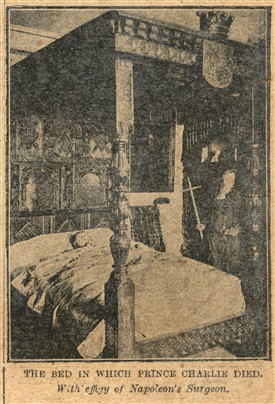
The bed in which Prince Charlie died from 'The Golden Penny', May 4th 1901
Courtesy of Manuscripts and Special Collections, The University of Nottingham, MS 237/2/7
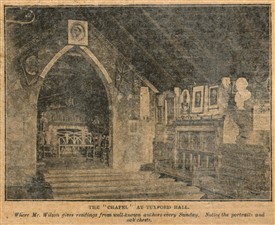
The Chapel from 'The Golden Penny' May 4th 1901
Courtesy of Manuscripts and Special Collections, The University of Nottingham, MS 237/2/7
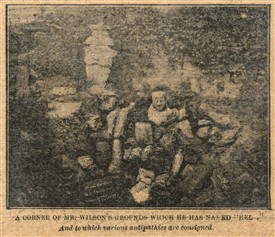
Mr Wilson's 'inferno' from 'The Golden Penny' May 4th 1901
Courtesy of Manuscripts and Special Collections, The University of Nottingham, MS 237/2/7
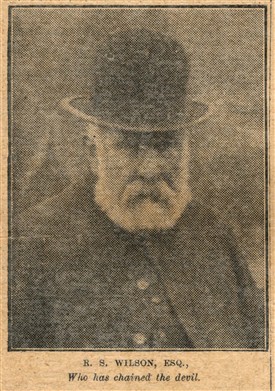
Mr Wilson from 'The Golden Penny' May 4th 1901
Courtesy of Manuscripts and Special Collections, The University of Nottingham, MS 237/2/7
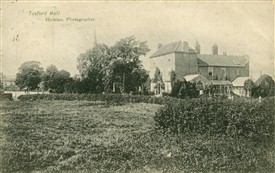
Tuxford Hall in an early 20th century postcard
The Author
The remarkable story of a Georgian house
By Jayne Amat
The present Tuxford Hall was built in the late 18th century by the White family of Tuxford and Wallingwells. The entrance façade is typically Georgian in appearance but the pretty garden front is quite unexpected and has two large bowed bays in the Gothick style. The hall occupies the site of the White’s old manor house, which according to ‘Some Account of the Family of White of Tuxford and Wallingwells’, by Miss M H Towry White, 1886, had been used as a dower house until it fell into disrepair. Much of the Tuxford estate was sold to the Duke of Newcastle in 1820 but an estate map of c1820-1830 (held in Manuscripts and Special Collections, The University of Nottingham) shows that the White family retained ownership of the hall after the death of Sir Thomas Woollaston White in 1817. His widow, Lady Elizabeth White, lived there probably until her death in 1850.
Nottinghamshire directories tell us that John Bygate, a horse dealer, resided there in 1864. By 1869, a very busy George Andrews is listed as the occupier. He’s described as “farmer, maltster, corn, coal, seed and tillage merchant, and agent to the Royal Farmers’ and Accidental Insurance Offices”.
The most interesting occupier was certainly Mr Robert Stretton Wilson, a veterinary surgeon and farmer with a passion for collecting, who lived at the hall from at least 1876 until his death. Charles F. Shaw’s article “A Gentleman who claims to have tamed the devil” for the journal The Golden Penny (May 4th 1901), describes Mr Wilson as “an enthusiastic archaeologist and art collector, his house, a roomy, well-built mansion occupying a commanding position in the centre of pleasant grounds, is literally packed from basement to ceiling with treasures of art, archaeological remains, and valuable curios from all corners of the world.” He goes on to describe some of the curios, “There are giant pea-pods from New Zealand, kangaroos from Australia….primitive pottery found on the Lincolnshire fens, relics from York Minster, exquisite lace work from Welbeck Abbey, articles worn by Prince Charles, a vase presented to the Duke of Newcastle by the Emperor Nicholas, Lord Byron’s bed and table from Newstead, the bed on which Prince Charles slept, Lord Nelson’s sword, hat worn by Wellington on the field of Waterloo, Roman urns and weapons, vases used by the monks of Bolton Abbey, church brasses recording the deaths of Wickcliffe and other famous men, with models of every celebrity of every age from the giant Goliath to the Iron Duke to the surgeon who attended Napoleon I. In fact it is impossible to mention one-half of the valuable relics and wonderful curios collected by this extraordinary man at his wonderful home.” The article included some fascinating photographs and they are reproduced here.
It would appear that word of Mr Wilson’s collection had spread prior to the publication of Mr Shaw’s article because the Nottinghamshire Guardian of 12 February 1898 reports that seven young men from Retford called at Tuxford Hall on Sunday 30th January and asked Mr Wilson to let them see his curios. They were admitted and unfortunately one of the men, a groom called George Chapman, stole a small book of proverbs and a bronze medallion from the chimney piece. He was subsequently caught, charged with theft, and fined £1. He blamed drink for his actions and apologised.
As if the house wasn’t unique enough, Mr Wilson turned his attentions to the grounds too, where he created his very own version of “Hell”. The entrance to this inferno (actually a shallow pit) was guarded by large statue of Satan, bound in chains, holding a skull, and grinning up at the nearby church spire (interestingly, Mr Wilson had fallen out with the local vicar, who refused to make him a church warden, so he built himself a private chapel inside Tuxford Hall, from where he gave readings on Sundays). Mr Wilson cast into this hellish pit all the persons and vices he disliked, such as “the Tobacco Devil”, “King Alcohol”, “The woman with the proud look and the lying tongue”, “The person with the hard heart”, “Liars”, “Thieves”, and “Murderers”. An early 20th century postcard (published by Davages of Newark) shows the pit looking rather crowded!
After the death of his wife Eliza in 1882, Mr Wilson appears to have lived alone in the house with only servants for company. Sadly, after his own death in 1904 the contents of the inferno, together with the contents of Tuxford Hall, were sold during a two day auction which attracted the attention of newspapers from as far afield as New Zealand. A catalogue was printed to accompany the sale but sadly it has proved impossible to locate a copy and so instead we must reply on the numerous contemporary press reports for details. The Manchester Guardian, 3rd December 1904, reveals that “The furniture of the hall throughout was of old oak. A dining table, 6ft by 3ft, dated 1620, the sides and ends carved and beaded, and the legs beautifully carved, went to Mr Herbert Marshall of Gainsborough for £140. The table was formerly the property of Lord Byron. For a baronial serving table, 10ft in length, which was some time ago removed from Blyth Hall, Mr Harris of London, paid £50. For four oak Stuart chairs, crown and angel pattern, Lord Cowley paid £65. A carved and inlaid bedstead, the posts of which are said to have originally formed part of the bedstead on which King John died in Newark Castle drew £50. A Tudor one, with carved panels and figures at the side, given by Lord Byron to his housekeeper (Mrs Broughton), from whose daughter Mr Wilson secured it, was sold for £33. Of the armchairs there was one, dated 1595, which Mr Wilson obtained from an old priory in Sussex. The legs were richly carved, and winged lions formed the legs and supports. For this £20 was given. Among the vast quantity of curios and old weapons was a bracelet said to be made of the hair of Queen Victoria, entwined with gold lace. It was bought for 17s.”
We know from other newspaper reports that the auctioneer of the two-day sale, Mr Kidd, tried to hurry the bidders along so that he could move on to the most exciting part of the sale – the contents of the hellish pit in the grounds. When the moment finally came, Mr Kidd took off his top hat and bowed to the effigy of Satan (which, by the way, was sold to a local bidder for 30s). Bidding for the figures in the pit was a little slow and Mr Kidd tried to encourage the crowd by suggesting that the successful purchaser could “show his treasures from hell in music-halls.” The contents of the pit finally achieved £2 10s but unfortunately, we do not know what the new owner (a Newark resident) did with his unusual acquisitions.
And so ended a remarkable chapter in Tuxford Hall’s history. Mr Wilson’s grandson, William Robert Wilson, a colliery manager, resided at the hall in 1911, possibly with his mother (Mr Wilson’s daughter-in-law). She is probably the “Mrs Wilson” of Tuxford Hall mentioned in the Nottinghamshire directories for 1908 and 1912.
Subsequent residents (with key dates taken from Kelly’s Nottinghamshire directories, and telephone books) were: Peter Bruce Whitington, surgeon and registrar (1916-1922), Douglas Clark (1925), W.E. Jones (1928), Humbert Arthur D. Cherry Downs (1936), Mrs G.I. Whitington (1941), and J.G. Tait (1949-1955). An advertisement in Country Life magazine records that Mr Tait put the hall up for sale in 1955 as he was “leaving the district”. The hall was purchased by the National Coal Board (possibly from Mr Tait), who used it to house senior staff. They put it up for sale in 1964 (according to a local newspaper report). Tuxford Hall was for sale again in 2012, with a guide price of £650,000. Looking at the photographs in the sale brochure of an up-to-date, attractively decorated residence, it’s hard to imagine that it was once filled to the brim with Robert Stretton Wilson’s extraordinary treasures.